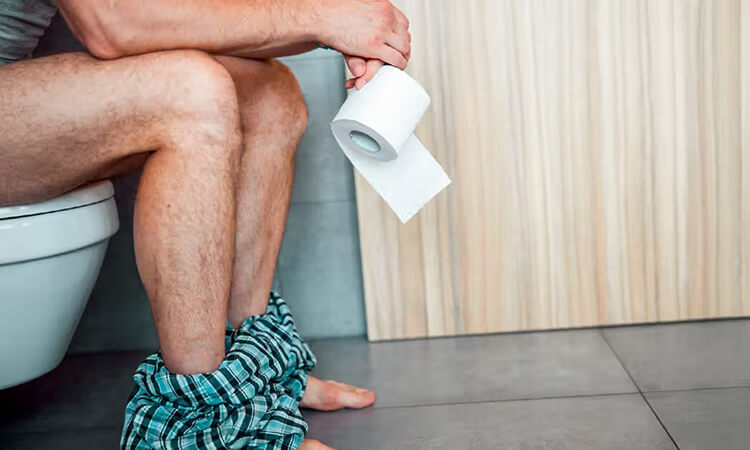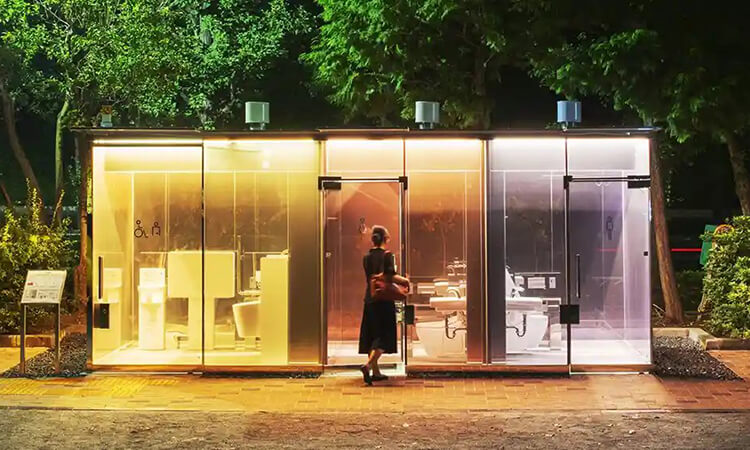“I’ve been sitting here forever — my stomach feels heavy and nothing’s happening.”
“Every time I go, it’s dry, painful, and sometimes even bleeds.”
If any of that sounds familiar, you’re far from the only one. Constipation is one of the most common digestive issues in the U.S., affecting roughly 15–20% of adults, according to the National Institute of Diabetes and Digestive and Kidney Diseases (NIDDK). It’s especially common among people who sit for long hours, older adults, and anyone whose diet lacks fiber or hydration.
But constipation isn’t just uncomfortable — when ignored, it can lead to issues like hemorrhoids, intestinal sluggishness, or even more serious gut problems over time.
The good news? You don’t have to depend on harsh laxatives to get things moving again. With a few simple, science-backed changes to your daily routine — including tweaks to your diet, hydration, and bathroom habits — you can naturally relieve constipation and restore regular, healthy digestion.
First, Understand Why You’re Constipated

Before you can fix constipation on the toilet, you need to understand what’s causing it. In most cases, constipation isn’t a disease — it’s a result of everyday habits that slow down your digestive system.
Normally, food moves through your intestines in about 12 to 24 hours. But when transit time stretches beyond 72 hours, your colon absorbs too much water from the stool, leaving it dry, hard, and difficult to pass.
Here are three common habits that actually make constipation worse:
- Ignoring the urge to go
Holding it in because you’re at work, driving, or “too busy” sends the wrong signal to your body. Over time, your intestines get used to ignoring the urge, dulling your natural bowel reflexes. The longer you wait, the harder it becomes to go — literally.
- Relying too much on laxatives
Stimulant laxatives like senna or rhubarb can offer quick relief, but frequent use can backfire. They irritate your intestinal lining and weaken the muscles that help push stool through. Eventually, your body may stop moving on its own — making you dependent on laxatives just to stay regular.
- Scrolling on your phone while on the toilet
We’re all guilty of it — checking texts, reading Reddit, or getting lost on TikTok. But sitting too long on the toilet (especially over 10 minutes) can increase pressure in the rectal veins, which may worsen constipation and even lead to hemorrhoids.
How to Relieve Constipation on the Toilet Immediately
If you’re already sitting on the toilet and things just aren’t moving, don’t force it — straining can cause small tears (anal fissures) or even hemorrhoids. Instead, try these safe, natural techniques to help your stool pass more easily and relieve the discomfort fast.
1. Adjust Your Posture — Mimic a “Squatting” Position
Modern toilets may look sleek, but they’re not exactly designed for healthy bowel movements. Sitting creates a 90-degree angle between your rectum and anus, which makes it harder for stool to pass.
When you squat, that angle opens closer to 180 degrees, straightening the colon and allowing waste to move through more smoothly.
How to do it:
Grab a small footstool about 6–8 inches high and place it in front of your toilet. Rest your feet on it, lean your torso slightly forward, and place your hands on your knees. This “squat-like” posture helps reduce rectal pressure and promotes a more natural bowel movement.
Pro tips:
- Don’t hunch too far forward — keep your back naturally curved and your belly relaxed.
- Use gentle abdominal pressure instead of holding your breath or straining, which can worsen pelvic tension.
2. Try a Gentle Abdominal Massage
If you feel the urge but can’t quite go, a gentle belly massage can stimulate intestinal movement and help stool travel downward.
How to do it:
Place your right hand over your belly button and massage in slow, circular motions clockwise — the same direction your intestines move. Apply light but steady pressure — enough to feel movement, but not pain. Massage for about 1–2 minutes, repeating 2–3 times if needed.
Why it works:
Your intestines move in a clockwise pattern — from the ascending to transverse, then descending colon. Massaging in this direction naturally boosts peristalsis, helping relieve mild constipation and bloating.
3. Use a Warm Sitz Bath Afterward
If hard stool causes pain, irritation, or tiny tears around the anus, a warm sitz bath can help soothe the area and prevent further damage.
How to do it:
Fill a shallow basin or bathtub with warm water around 100–104°F (comfortably warm, not hot). Sit with your hips submerged for 10–15 minutes. While soaking, gently contract and relax your anal muscles — like doing a Kegel exercise — to improve blood flow and relax the sphincter.
Aftercare:
Pat the area dry with a soft towel — don’t rub. If you’re dealing with hemorrhoids or small fissures, you can add a small amount of Epsom salt (magnesium sulfate) under your doctor’s guidance to help reduce inflammation.
Bonus Tip:
If you’re upgrading your bathroom, consider investing in a smart bidet toilet. Premium models offer warm-water cleansing, hands-free flushing, and warm-air drying — all of which reduce irritation and encourage healthier, more relaxed bowel movements over time.
Daily Habits to Finally Say Goodbye to Constipation
Quick fixes can help in the moment, but if you want lasting relief from constipation, it’s all about changing what you do every day. By addressing the root causes — your diet, routine, and lifestyle — you can train your digestive system to stay regular and keep constipation from coming back.
1. Eat More Fiber and Stay Hydrated for Softer, Easier Stools
How your stool looks and feels depends mostly on fiber and water intake. Fiber works like a sponge — it absorbs water, adds bulk, and helps move stool through your intestines. Without enough fiber or fluids, stool dries out and becomes difficult to pass.
Aim for about 25–30 grams of fiber per day, as recommended by the USDA, combining both soluble and insoluble types for the best results.
Insoluble fiber:
Whole grains like oats, brown rice, and corn; veggies like celery, spinach, and leeks; and fruit skins (like apples and pears — just wash them well).
Soluble fiber:
Beans such as black beans, chickpeas, and kidney beans; mushrooms; and fruits like ripe bananas (avoid green ones), kiwifruit, dragon fruit, and prunes.
Pro tips:
- Don’t jump from zero to 30 grams overnight — too much fiber too fast can cause bloating and gas. Gradually increase your intake by about 5 grams a day so your gut has time to adjust.
- Drink 6–8 cups (1.5–2 quarts) of water daily, spread evenly throughout the day.
- Try starting your morning with a glass (about 10 oz) of warm water — it gently wakes up your digestive system and may help trigger a natural bowel movement.
2. Build a Routine — Train Your Body’s Natural “Bowel Clock”
Your intestines have their own rhythm. By keeping a consistent schedule, you can train your bowels to work at the same time each day.
Best times to go:
- Right after waking up: Standing up triggers a natural colon reflex that gets things moving.
- Within 30 minutes after meals: Especially breakfast, which activates the gastrocolic reflex — your gut’s built-in “go” signal.
How to train your bowels:
Even if you don’t feel an immediate urge, sit on the toilet for about 10 minutes after waking or eating. Use a footstool if needed to get into a better position. Over time, your intestines will start responding automatically, creating a healthy, predictable pattern.
3. Move Your Body — Just 30 Minutes a Day Can Wake Up Your Gut
A sedentary lifestyle is one of the biggest constipation triggers. Regular movement helps stimulate your intestines, improve circulation, and keep digestion on track.
Great options:
- Low-impact cardio: Brisk walking, jogging, swimming, or cycling for about 30 minutes a day, at least 5 days a week.
- Abdominal breathing: Sit or lie down with one hand on your stomach. Inhale so your belly rises, then exhale and let it fall. Do 10–15 reps, 2–3 times daily.
- Kegel exercises: Contract your anal muscles as if you’re trying to stop a bowel movement. Hold for 3–5 seconds, then release. Repeat 10–15 times, 3 sets per day. This strengthens the pelvic floor and helps prevent hemorrhoids.
Quick tip:
Even a 10-minute walk after meals can make a big difference — it helps your digestive system kick into gear and prevents stool from sitting too long in the colon.
4. Avoid Hidden Triggers That Quietly Slow Digestion
Improving your habits is one part of the equation — but avoiding constipation triggers is just as important. Here are a few common ones to watch out for:
- Cut back on low-fiber: White bread, white rice, pastries, and fried snacks lack fiber and reduce intestinal stimulation.
- Limit irritants: Spicy foods, caffeine, and alcohol can irritate your digestive tract and cause irregular bowel patterns (sometimes alternating constipation and diarrhea).
- Don’t sit too long: Stand up and move for about 5 minutes every hour. Stretch, refill your water, or take a quick walk. If your job requires sitting for long periods, try light abdominal massage or Kegel exercises at your desk to keep your intestines active.
When to See a Doctor: Don’t Ignore Unusual Constipation
In most cases, constipation improves with better diet, hydration, and lifestyle habits. But sometimes, constipation can be a sign of something more serious going on in your digestive system.
If you notice any of the symptoms below, it’s time to check in with your doctor — especially a gastroenterologist. These signs could indicate an underlying issue such as intestinal polyps, inflammation, or even partial blockage.
See a doctor right away if you experience:
- Sudden, worsening constipation accompanied by persistent abdominal pain or bloating, especially on the lower left side, that doesn’t go away after a bowel movement.
- Blood in your stool — whether it’s bright red or dark — or a noticeable change in stool shape (for example, narrow or “pencil-thin” stools).
- Unexplained weight loss of more than 10–12 pounds within a month, along with loss of appetite or unusual fatigue.
- Chronic constipation lasting over 3 months, not improving with dietary changes, exercise, or hydration — or if you’ve become dependent on laxatives to pass stool.
If any of these red flags apply to you, don’t try to manage it on your own. A doctor may recommend tests such as a colonoscopy, stool analysis, or imaging studies to rule out more serious conditions.
Catching potential issues early can make all the difference — not only for your comfort, but for your long-term digestive health.
Ending
Constipation didn’t happen overnight — and it won’t disappear overnight either.
Just as your intestines have adapted to less-than-ideal habits over time, they need time to adjust to healthier routines. Don’t expect instant results after eating a single prune or taking one short walk.
For most people, it takes about 2–4 weeks of consistent effort before noticing real improvements in bowel movement frequency and comfort.
Here’s the secret to lasting relief:
- Fuel your gut right: plenty of fiber and adequate hydration.
- Stick to a routine: train your body’s natural “bowel clock.”
- Keep moving: daily physical activity helps your intestines stay active.
By giving your digestive system the right care and consistency, you can break the cycle of discomfort and make regular, effortless bowel movements a natural part of your day again.







